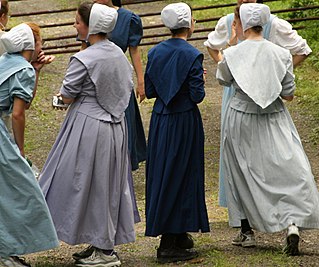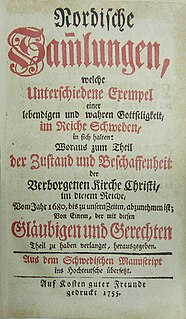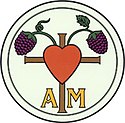
The Church of the Brethren is an Anabaptist Christian denomination with origins in the Schwarzenau Brethren that was organized in 1708 by Alexander Mack in Schwarzenau, Germany. The denomination holds the New Testament as its only creed. Historically, the church has taken a strong stance for nonresistance or pacifism—it is one of the three historic peace churches, alongside the Mennonites and Quakers. Distinctive practices include believer's baptism by trine immersion; a threefold love feast consisting of feet washing, a fellowship meal, and communion; anointing for healing; and the holy kiss. Its headquarters are in Elgin, Illinois, United States.

The Old German Baptist Brethren (OGBB) is a conservative Plain church which emerged from a division among the German Baptist Brethren in 1881 being part of the Old Order Movement. Like the church it emerged from, it has roots both in Anabaptism and in Radical Pietism. It practices adult believers baptism as the biblically valid form of baptism. It is also characterized by strict religious adherence with rejection of modern culture and modern assimilation. It is one of several Schwarzenau Brethren groups that trace their roots to 1708, when eight believers founded a new church in Schwarzenau, Germany. The Old German Baptist Brethren church has about 4,000 baptized members.

The Schwarzenau Brethren, the German Baptist Brethren, Dunkers, Dunkards, Tunkers, or sometimes simply called the German Baptists, are an Anabaptist group that dissented from Roman Catholic, Lutheran and Reformed European state churches during the 17th and 18th century. German Baptist Brethren emerged in some German-speaking states in western and southwestern parts of the Holy Roman Empire as a result of the Radical Pietist revival movement of the late 17th and early 18th centuries.

The Brethren Church is an Anabaptist Christian denomination with roots in and one of several groups that trace its origins back to the Schwarzenau Brethren of Germany.

The Church of God was a religious group that was formed in 1848 by dissidents of the Schwarzenau Brethren.

The Old Order German Baptist Brethren, also called Petitioners, are a small group of very conservative Schwarzenau Brethren.

The Dunkard Brethren are a small group of primarily American conservative Schwarzenau Brethren, which organized in 1926 when they withdrew from the Church of the Brethren in the United States. In 1980 they had approximately 900 members in 25 congregations, primarily in mid-Atlantic and midwestern states that had been areas of German settlement in the colonial and later periods.

The Old Order River Brethren are a small Old Order River Brethren denomination of Anabaptist Christianity with roots in the Mennonite Church and the Radical Pietist movement of the Schwarzenau Brethren.

The River Brethren are a group of historically related Anabaptist Christian denominations denominations originating in 1770, during the Radical Pietist movement among German colonists in Pennsylvania. In the 17th century, Mennonite refugees from Switzerland had settled their homes near the Susquehanna River in the northeastern United States.

A horse and buggy or horse and carriage refers to a light, simple, two-person carriage of the late 18th, 19th and early 20th centuries, drawn usually by one or sometimes by two horses. Also called a roadster or a trap, it was made with two wheels in England and the United States. It had a folding or falling top.

Old Order Mennonites form a branch of the Mennonite tradition. Old Order are those Mennonite groups of Swiss German and south German heritage who practice a lifestyle without some elements of modern technology, who dress plainly and who have retained the old forms of worship, baptism and communion.

Radical Pietism are Pietists who decided to break with denominational Lutheranism, forming separate Christian churches. Radical Pietists contrast with Church Pietists, who chose to remain within their Lutheran denominational settings. Radical Pietists distinguished between true and false Christianity.. They separated from established churches to form their own sects.

Christoph Sauer was the first German-language printer and publisher in North America.

The Old Brethren German Baptists, also called Leedyites, are the most conservative group of Schwarzenau Brethren. They live in Indiana and Missouri.

The Old German Baptist Brethren, New Conference is a church belonging to the Schwarzenau Brethren tradition, that formed in 2009 as a result of a split among the Old German Baptist Brethren.
A Seeker is a person likely to join an Old Order Anabaptist community, like the Amish, the Old Order Mennonites, the Hutterites, the Old Order Schwarzenau Brethren or the Old Order River Brethren. Among the 500,000 members of such communities in the United States there are only an estimated 1,200 to 1,300 outsiders who have joined them.
Old Order Brethren are Old Order plain groups of the Schwarzenau Brethren. There are five of these “Old Order” groups:
The Old Order Movement is a religious movement to preserve the old ways of Anabaptist religion and lifestyle. Historically, it emerged in the second half of the 19th century among the Amish, Mennonites of South German and Swiss ancestry as well as the Schwarzenau Brethren in the United States and Canada. The movement led to several Old Order divisions from mainstream Anabaptist groups between 1845 and 1901. All Old Order groups that emerged after 1901 divided from established Old Order groups or were formed by people coming from different Old Order groups. The highly conservative Old Colony Mennonites and the Hutterites were not directly connected to this movement.

Samuel Kinsey was a Christian minister and leader of the reactionary wing of the German Baptist Brethren that became the Old German Baptist Brethren.
The believers' Church is a theological doctrine of Evangelical Christianity that teaches that one becomes a member of the Church by new birth and profession of faith. Adherence to this doctrine is a common feature of defining an Evangelical Christianity church.






